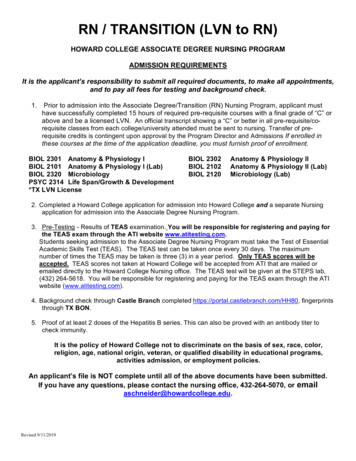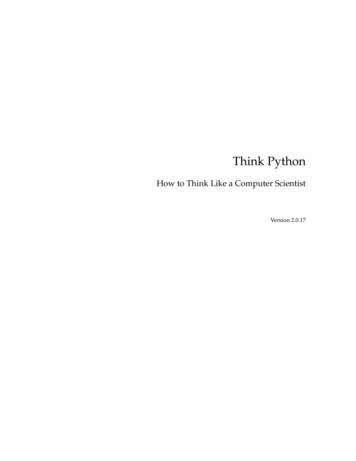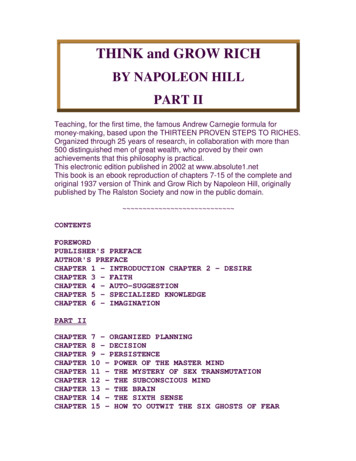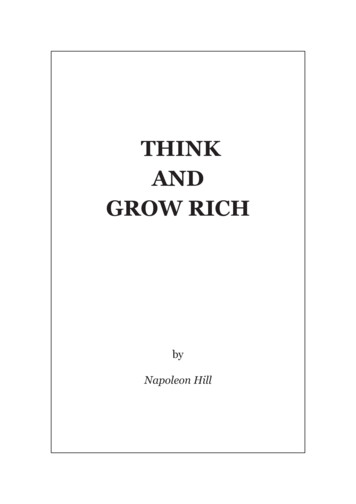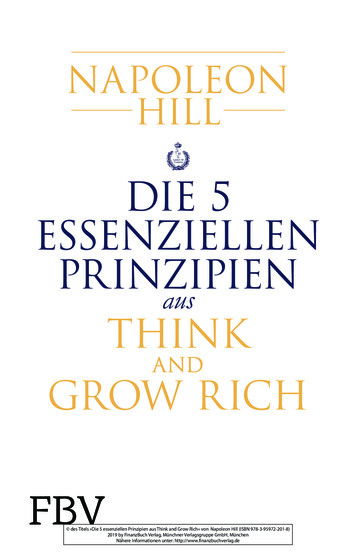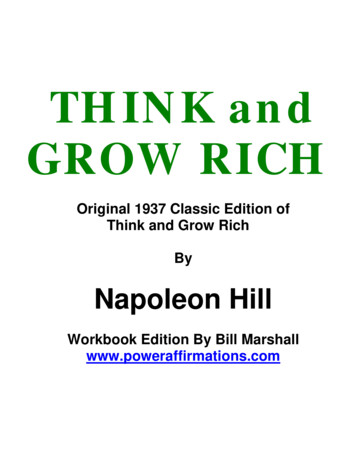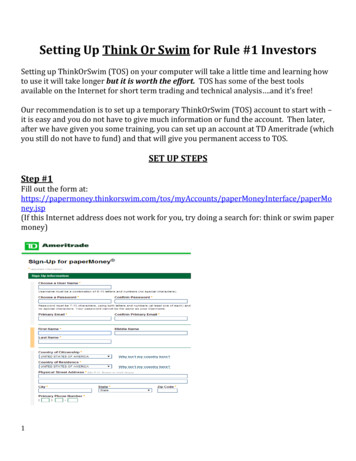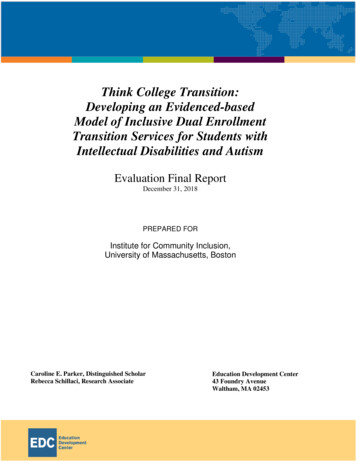
Transcription
Think College Transition:Developing an Evidenced-basedModel of Inclusive Dual EnrollmentTransition Services for Students withIntellectual Disabilities and AutismEvaluation Final ReportDecember 31, 2018PREPARED FORInstitute for Community Inclusion,University of Massachusetts, BostonCaroline E. Parker, Distinguished ScholarRebecca Schillaci, Research AssociateEducation Development Center43 Foundry AvenueWaltham, MA 02453
Contents1.Introduction . 31.1. Evaluator . 31.2. Intervention background/history . 31.3. Confidentiality protection . 31.4. Independence of evaluation . 32.Brief Summary of Intervention and Evaluation Design . 43.Impact Evaluation . 63.1. Impact Study . 63.1.1.3.1.2.3.1.3.3.1.4.3.1.5.3.1.6.Research questions .6Comparison conditions .7Sample identification, selection and assignment .7Data collection for the evaluation of impacts . 10Statistical analysis of impacts on students . 15Baseline balance testing . 183.2. Additional analyses involving outcomes . 184.Implementation Evaluation . 194.1. Logic model for the intervention . 194.2. Research questions for evaluation of implementation . 214.3. Measuring fidelity of implementation. 214.4. Calculating fidelity scores across the full sample for each key component . 264.5. Data collection plan . 264.6. Fidelity reporting plan . 275.Results. 295.1. Confirmatory Contrasts Results . 295.1.1.5.1.2.5.1.3.5.1.4.Confirmatory Contrast 1: Job seeking skills . 29Confirmatory Contrast 2: Career readiness . 29Confirmatory Contrast 3: Self-determination . 29Confirmatory Contrast 4: Integrated paid employment . 315.2. Exploratory Contrasts Results . 355.3. Implementation Fidelity Results . 376.Conclusion . 407.Appendices . 437.1. Appendix A: Descriptives and Analyses for Exploratory Contrasts 1-3 . 437.2. Appendix B: Descriptives and Analyses for Exploratory Contrasts 4-6, 8 . 477.3. Appendix C: Descriptives and Analyses for Exploratory Contrast 7 . 502
1. Introduction1.1. EvaluatorThe Education Development Center, Inc. (EDC) conducted the independent evaluation of the i3development grant. The evaluation was led by Caroline E. Parker, Ed.D., whose contact information islisted belowCaroline E. Parker, Ed.D.Distinguished Scholar, EDC43 Foundry AvenueWaltham, MA 02453-831617-618-2740CParker@edc.org1.2. Intervention background/historyThink College Transition (TCT) is a refinement and more strategic version of college-based dualenrollment transition services for students with disabilities. Dual enrollment programs have beenimplemented throughout the country and in Massachusetts. In Massachusetts specifically TCT leveragedan existing state grant funded program called the Inclusive Concurrent Enrollment Initiative that supportsthe creation of partnerships between institutes of higher education (IHEs) and local school systems toserve students with disabilities who are in the process of transition from school to adult life. While theseprograms each involve college, they are inconsistent in their use of critical components such as personcentered planning, peer mentors, inclusive course access, and customized employment strategies.Additionally there had not been any evaluation conducted on these current practices. The modeldeveloped and implemented (TCT model) incorporated each of these essential components as part of acohesive and inclusive transition program. This represents the first time this intervention has beenimplemented or evaluated.1.3. Confidentiality protectionIRB approval was obtained from EDC (evaluator organization), as well as from the three institutes ofhigher education: Holyoke Community College (HCC), Westfield State University (WSU), andBridgewater State University (BSU). Research protocols delineated by each of the school districts thatindicated their interest in participating in the evaluation were followed. IRB documents were approved byEDC (6/29/15), HCC (8/11/15), WSU (8/24/15), and BSU (5/16/2016). IRB documents were submitted toschool districts following the policies in each participating district.1.4. Independence of evaluationEDC conducted the evaluation of the TCT model in a manner that meets the standards for independencefor i3 grants. Although EDC and UMB (the program developer) worked collaboratively on aspects of thestudy such as the development of the logic model and the measurement of implementation and fidelity,the program developer was not be involved in the collection of data used in the analysis of confirmatoryoutcomes. These data were collected directly by EDC researchers on iPads using Qualtrics surveys.Qualtrics is an online survey platform that uses Transport Layer Security (TLS) encryption (also knownas HTTPS) for all transmitted data. All Qualtrics surveys and data were password protected. Only theexternal evaluators had access to the surveys and student data.3
2. Brief Summary of Intervention and Evaluation DesignThis study was an evaluation of the i3 development grant Think College Transition (TCT), an inclusivedual enrollment transition model to improve achievement and post-school outcomes for students withintellectual disabilities or autism (ID/A). The model offers an innovative approach to transition servicesfor students with intellectual disabilities and autism by providing participation in inclusive academic andsocial environments of a college campus with same-aged peers rather than continuing to receive transitionservices in typical high school environments. The TCT model is an inclusive comprehensive collegebased transition model where students are fully included on campus in all aspects of a complete collegeexperience, receiving supports as necessary (e.g., coaching and/or peer mentor, disability services office).The student’s day consists of course participation, social events, and career development activities andintegrated competitive employment moving their transition services away from a high school-basedapproach to a college and community-based approach. TCT includes partnership development andtechnical assistance for university- and district-level staff in order to implement the model with studentswith intellectual disabilities and autism. This study examined the impact of TCT services on the jobseeking skills, career readiness, self-determination, college self-efficacy, and employment of ID/A youth.The study used a quasi-experimental design comparing students with ID/A participating in the TCTmodel at three universities in Massachusetts with students with ID/A participating in business as usualtransition services through their school districts. In Year 1, students in their first year of enrollment in theTCT dual-enrollment programs at Holyoke Community College (HCC) and Westfield State University(WSU) in 2015-2016 were recruited to participate in the intervention condition (students in their secondyear of enrollment in 2015-2016 were not eligible to participate in the study). Comparison students weredrawn from two types of districts. The first type are districts that sent students to HCC and/or WSU (12districts in total), and so the comparison students have comparable experiences to the interventionstudents except for participation in the TCT program. The second type are districts that do not sendstudents to HCC and/or WSU and do not participate in any other dual enrollment program.In Year 2, students in their first year of enrollment in the TCT dual-enrollment programs at HolyokeCommunity College (HCC), Westfield State University (WSU), and Bridgewater State University (BSU)in 2016-2017 were recruited to participate in the intervention condition. Comparison students were drawnfrom two types of districts. The first type are districts that sent students to HCC, WSU, and/or BSU (35districts in total), and so the comparison students have comparable experiences to the interventionstudents except for participation in the TCT program. The second type are districts that do not sendstudents to HCC, WSU and/or BSU and do not participate in any other dual enrollment program.This Year 2 sampling process was repeated for two cohorts (2016-2017 and 2017-2018). All students,both intervention and comparison, were 18-22 year-old students enrolled in transition services who had anintellectual disability or had a dual diagnosis of autism and an intellectual disability. Intellectual disabilitywas defined as meeting the definition from the American Association of Intellectual and DevelopmentalDisability (AAIDD): Intellectual disability is characterized by significant limitations both in intellectualfunctioning and adaptive behavior as expressed in conceptual, social, and practical skills, which areapparent prior to the age of 18. Autism was defined as meeting the definition of ASD as described in theDiagnostic and Statistical Manual of Mental Disorders (5th ed.; DSM-5; American PsychiatricAssociation, 2013). Eligible participants in the evaluation had no previous participation in a dualenrollment program. Characteristics such as gender, ethnic background, and health status did notinfluence subject selection.Baseline data was collected at the beginning of the each cohort’s participation. The impacts on studentswere assessed in the winter and spring of 2016, 2017 and 2018. Impacts at the end of one year includedCohort 1 students in spring 2016, when they had one year of either business as usual or TCT services,4
Cohort 2 students in the spring of 2017, and Cohort 3 students in the spring of 2018. Measures of theimpact of two years of TCT included Cohort 1 and Cohort 2 students. Our confirmatory contrastscompared intervention and comparison students on measures of job-seeking skills, career readiness, andself-determination one year after participating. We also conducted exploratory contrasts. One set ofcontrasts compared the sub-group of students from Cohorts 1, 2, and 3 who completed the transitionprogram on measures of employment six months after exiting transition services. Another exploratorycontrast also looked at whether students enrolled in the TCT model for two years had higher levels ofcollege self-efficacy compared to students who participated in the TCT model for one year.Our analyses used ordinary least squares regression to compare the magnitude and direction of thedifference between the post-intervention scores, expressed as a standardized effect size difference, forstudents in the intervention and comparison conditions, after controlling for pre-intervention scores.Linear growth modeling was used in the exploratory contrasts to determine whether the TCT model hadan effect on the three outcomes of interest over time. This analysis procedure allowed us to examinedifferences among individuals at the start of the intervention, to examine growth in the three outcomesacross the three time points (baseline, winter, spring) as a function of students’ participation in theintervention, and to determine differences between the intervention and comparison groups in theoutcomes of interest. The evaluation planned to also use logistic regression to measure the effect of theTCT model on students’ employment 6 months after the completion of the intervention (as an exploratorycontrast), but an insufficient sample size precluded formal statistical analysis.The theory of action underlying the TCT model is that a program of dual enrollment for students withID/A will lead to greater job-seeking skills, career readiness, self-determination, and college self-efficacy.The components of the TCT model included training provided to both high school and higher educationstaff involved in the program to provide them with the skills and knowledge necessary to implement theTCT model; the development of a collaborative partnership between the school district, higher educationinstitutions, and local partners; and student activities (person-centered planning, enrollment in collegecourses aligned with their career interests, participation in employment opportunities, and peer mentorsand/or instructional coaches). It was predicted that when the students participate in the TCT modelelements provided by the high school and higher education staff, they would experience positive changesin job-seeking skills, career readiness, self-determination, and college self-efficacy. In addition it waspredicted, they would be more likely to hold integrated paid employment after completing the TCT modelthan ID/A students in business as usual transition programs.The implementation evaluation measured the extent to which each of three components wereimplemented with fidelity. The i3 indicators of the TCT model (15 indicators in Year 1) which weremeasured as part of the fidelity of implementation evaluation made up the three major components of theintervention: the technical assistance and coaching that was provided to high school and higher educationstaff (one indicator); the program structures promoting community collaboration which were measured atthe program level (two indicators); and the component of student participation, measured at the studentlevel (twelve indicators in Year 1, ten indicators in Year 2 and Year 3). The implementation data wascollected by either the program staff or the transition specialists working with the students, and includedattendance records and documentation of student activities. The fidelity measurement was conducted onthe TCT program for three years, in 2015-16, 2016-17, and 2017-18.5
3. Impact EvaluationWe conducted one study with four research questions.3.1. Impact StudyWe used a quasi-experimental design in which intervention students enrolled in the TCT model at HCC,WSU, and BSU and comparison students received business as usual transition services in their schooldistricts. The study included three cohorts of students. Cohort 1 and Cohort 2 students received eitherbusiness as usual transition services or up to two years of TCT services. Cohort 3 received either businessas usual or one year of TCT services. Our confirmatory contrasts compared intervention and comparisonstudents on measures of job-seeking skills, career readiness, and self-determination one year afterparticipating, as well as on their employment status six months after exiting transition services. Themeasures of job-seeking skills and career readiness included Cohort 1, Cohort 2, and Cohort 3 students.The measure of self-determination included only Cohort 2 and Cohort 3 because the validated instrumentbecame available for use after Cohort 1 data collection had begun. We also conducted exploratorycontrasts. One set of contrasts compared growth over time between intervention and comparison studentson the three measures of job-seeking skills, career readiness, and self-determination. A second set ofcontrasts compared intervention students who completed two years of TCT with intervention studentswho completed one year of TCT on the three measures of job-seeking skills, career readiness, and selfdetermination as well as a measure of college self-efficacy. Another exploratory contrast comparedintervention and comparison students on a measure of employment six months after exiting transitionservices.3.1.1.Research questionsConfirmatory Contrasts1. Does one year of participation in the TCT model lead to higher levels of job-seeking skills for 1822 year old students with ID/A compared to job-seeking skills among comparison studentsreceiving the business as usual condition?2. Does one year of participation in the TCT model lead to higher levels of career readiness for 18-22year old students with ID/A compared to career readiness skills among comparison students in thebusiness as usual condition?3. Does one year of participation in the TCT model lead to higher levels of self-determination for 1822 year old students with ID/A compared to levels of self-determination among comparisonstudents in the business as usual condition?4. Are students with ID/A enrolled in the TCT model for one year more likely than comparisonstudents in the business as usual condition to be employed in integrated paid employment sixmonths after exiting transition services?Exploratory Contrasts1. Does one year of participation in the TCT model lead to higher growth over time in levels of jobseeking skills compared to students in the business as usual condition?2. Does one year of participation in the TCT model lead to higher growth over time in levels ofcareer readiness compared to students in the business as usual condition?3. Does one year of participation in the TCT model lead to higher growth over time in levels of selfdetermination compared to students in the business as usual condition?4. Do two years of participation in the TCT model lead to higher levels of job-seeking skills for 1822 year old students with ID/A compared to one year of participation
Dec 31, 2018 · In Year 2, students in the ir first year of enrollment in the TCT dual -enrollment programs at Holyoke Community College (HCC), Westfield State University (WSU), and Bridgewater State University (BSU) in 2016-2017 were recruited to participate in the intervention condition. Co

